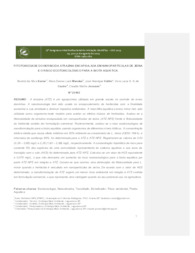Fitotoxicidade do herbicida atrazina encapsulada em nanopartículas de zeína e o risco ecotoxicológico para a biota aquática.
Fitotoxicidade do herbicida atrazina encapsulada em nanopartículas de zeína e o risco ecotoxicológico para a biota aquática.
Author(s): XAVIER, B. da S.; MENDES, M. D. L.; VALLIM, J. H.; CASTRO, V. L. S. S. de; JONSSON, C. M.
Summary: Resumo: A atrazina (ATZ) é um agroquímico utilizado em grande escala no controle de ervas daninhas. A nanotecnologia tem sido usada no encapsulamento de herbicidas com a finalidade aumentar a sua atividade e diminuir impactos ambientais. A macrófita aquática Lemna minor tem sido utilizada como organismo-teste modelo para avaliar os efeitos tóxicos de herbicidas. Avaliou-se a fitotoxicidade da atrazina encapsulada em nanopartículas de zeína (ATZ-NPZ) frente à fitotoxicidade do herbicida contido em formulação comercial. Posteriormente, avaliou-se o risco ecotoxicológico da nanoformulação para a biota aquática usando organismos de diferentes níveis tróficos. A concentração efetiva média que causa efeito inibitório em 50% referente ao crescimento de L. minor (CE50-168 h), e intervalos de confiança 95%, foi determinada para a ATZ e ATZ-NPZ. Registraram-se valores de 0,53 (0,26 – 0,86) mg/L e 2,26 (1,83 – 2,88) mg/L, respectivamente. A concentração hipotética de risco para somente 5% das espécies de uma comunidade representante do sistema aquático e sua zona de transição com o solo (HC5) foi determinada para ATZ-NPZ. Calculou-se um valor de HC5 equivalente a 0,079 mg/L, o que não demostra um aumento do risco ecotoxicológico para a biota aquática por parte ATZ-NPZ em relação a ATZ. Conclui-se que ocorreu uma diminuição da fitotoxicidade para L. minor quando o herbicida é veiculado em nanopartículas de zeína. De acordo com o valor de HC5 determinado, a nanoformulação de ATZ sugere um menor risco ambiental em relação à ATZ contida em formulação comercial, o que representa uma vantagem quanto ao seu potencial uso na agricultura. -- Abstract: Atrazine (ATZ) is an agrochemical widely used in weed control. Nanotechnology has been used in the encapsulation of herbicides in order to increase their activity and reduce environmental impacts. The aquatic macrophyte Lemna minor has been used as model test-organism to evaluate the toxic effects of herbicides. The phytotoxicity of atrazine encapsulated in zein nanoparticles (ATZ-NPZ) was evaluated against the phytotoxicity of the herbicide contained in a commercial formulation. Subsequently, the ecotoxicological risk of the nanoformulation for the aquatic biota was evaluated using organisms from different trophic levels. The mean effective concentration causing a 50% inhibitory effect on L. minor growth (EC50-168 h), and 95% confidence intervals, were determined for ATZ and ATZ-NPZ. Values of 0.53 (0.26 – 0.86) mg/L and 2.26 (1.83 – 2.88) mg/L were recorded, respectively. The hypothetical risk concentration for only 5% of the species of a representative community of the aquatic system and its transition zone with the soil (HC5) was determined for ATZ-NPZ. An HC5 value equivalent to 0.079 mg/L was calculated, which does not demonstrate an increase in the ecotoxicological risk for the aquatic biota by ATZ-NPZ in relation to ATZ. It is concluded that there was a decrease in phytotoxicity for L. minor when the herbicide is carried in zein nanoparticles. Due to the determined HC5 value, the ATZ nanoformulation suggests a lower environmental risk compared to the ATZ contained in a commercial formulation, which represents an advantage regarding its potential use in agriculture.
Publication year: 2023
Types of publication: Paper in annals and proceedings
Unit: Embrapa Environment
Observation
Some of Embrapa's publications are published as ePub files. To read them, use or download one of the following free software options to your computer or mobile device. Android: Google Play Books; IOS: iBooks; Windows and Linux: Calibre.
Access other publications
Access the Agricultural Research Database (BDPA) to consult Embrapa's full library collection and records.
Visit Embrapa Bookstore to purchase books and other publications sold by Embrapa.

